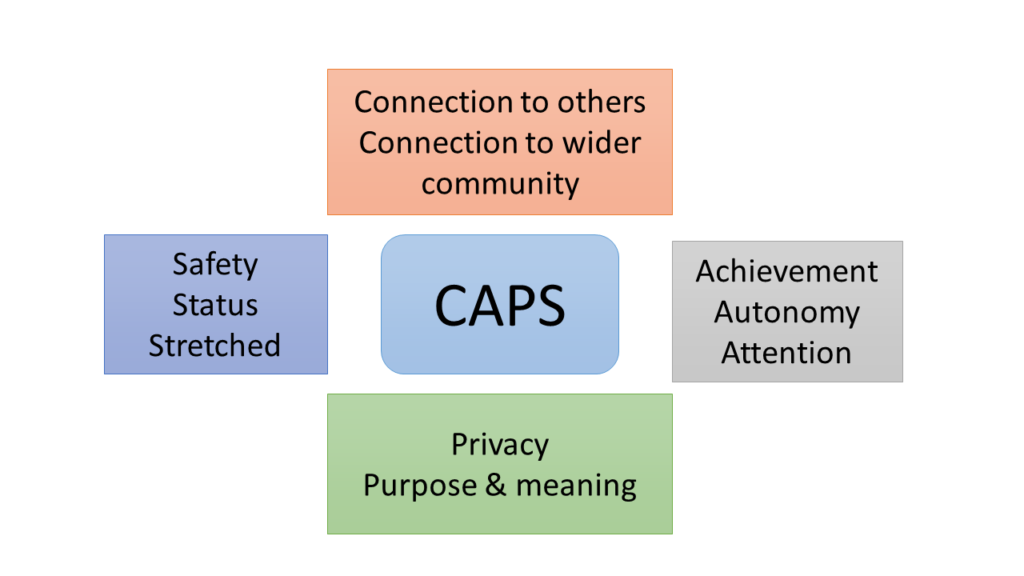
Fear of Failure
“He who fears being conquered is sure of defeat” Napoleon Boneparte Fear is often greater than the feared event itself
Human givens is a bio-psychosocial therapeutic approach, or organizing idea, developed by Joe Griffin and Ivan Tyrrell in the 1990s (Griffin and Tyrrell 2007).
The values, principles, and goals of human givens therapy
The human givens approach is underpinned by knowledge of:
Human givens therapy:
is collaborative draws upon a range of therapies for which there is an evidence base recognizes the reciprocal relationship between biological processes: perceptions; affective processes: feelings; cognitive processes: thoughts and behaviours pays respect to affective processes in bringing about change in thoughts and behaviours as a way of reducing symptoms and improving functioning focuses on the here and now rather than past experiences defines roles for both the therapist and the client, both of whom are active participants in therapy is non-voyeuristic, and therefore safe is brief and effective.
As described in a seminar on effective counselling based on the human givens approach, the therapeutic goal is ‘to relieve emotional distress quickly and help people to find ethical ways to meet their unfilled needs’ (Griffin 2008, p.4). The human givens approach aims to help others deal with problems at the level at which they originate, that is, in the subconscious part of the brain. The approach is non-voyeuristic in that experiences do not have to be shared at a great level of detail in order for them to be resolved. Human givens needs Human givens therapy works on the assumption that human beings have innate needs and resources both physical and emotional in nature. When these needs are not met or when resources are used incorrectly, emotional distress and mental health problems may occur. In psychotherapy, it is the emotional needs which are of major concern (Griffin and Tyrrell 2007). I have outlined the needs in the form of the acronym CAPS.
Others working to better understand emotional needs postulate alternative views regarding actual intrinsic needs. For example, relatedness, autonomy, and competence are concepts that are considered to take account of the essentials of the well-being of an individual (Deci and Ryan 2002). The human givens needs, connection to others, connection to wider community, friendship, attention, and privacy may all fall within the relatedness category. The human givens needs, autonomy, and competence appear to fit into the competence category, while security, status, and purpose and meaning seem to stand alone. They are, however, highly important in their contribution to an individual’s well-being, and unmet needs in these areas can threaten relatedness, autonomy, and competence. The Emotional Needs Audit (ENA) tool was developed by the co-founders of human givens therapy, for the purpose of assessing needs. The ENA form can be downloaded from www.hgi.org.uk.
For the purpose of this book, although comments may be made as to close ties between particular human givens needs, they will essentially be addressed on their own.

Within the human givens school of thought, those whose needs are well met in the world do not have mental health problems and better integrate with other people. Those whose needs are unfulfilled suffer distress and may develop mental illness, and/or, as a means of coping, involve themselves in antisocial behaviour (Griffin and Tyrrell 2007). The human givens resources that nature has provided us with may be viewed in Figure 2.2.
A combination of factors makes human givens therapy unique. It involves therapeutic processes typical to other psychotherapies already and included in the RIGAAR model. They relate to Rapport building; Information gathering; Goal setting; Agreeing a strategy; Accessing resources; and Rehearsal. As aforementioned, rapport building is built into the assessment and therapeutic structure, and is a major contributor to therapeutic change according to several eminent researchers (Bachelor and Horvath 2006; Lambert 1992; Rogers 1976).
Agreeing a strategy, or collaborating with the client on ways to address an issue, and adapting to their preferred learning styles, thereby providing opportunities for greater autonomy, may be quite different to that of more directive approaches, such as CBT. Although a less directive approach to therapy may be desirable and assist in the creativity of the approach on the one hand, on the other hand it may prevent professionals having the confidence to apply the approach to the emotional issues that young people bring to therapy. Therefore, it is hoped that the creation of a professional’s practical guide, such as this, or therapeutic manual on human givens therapy should facilitate its use.
Griffin (2008) asserted that no-one can be told how to do therapy, and the RIGAAR model indicates essential components within which the therapist and clients are free to choose strategies to address the client’s unmet emotional needs.
LeDoux (1998) highlighted the following:
Neuropsychological research about the order of events in brain functioning has revealed that emotions precede reason and perception and hence some emotional responses and memories may be formed without any conscious thought (LeDoux 1998). Therefore, the co-founders of the Human Givens Institute argue that it is the emotional arousal that causes black and white thinking (HGIPRN 2009).
It is widely known that evidence-based CBT is underpinned by the premise that the opposite occurs, that is, thoughts precede emotions. However, arguably, and in line with LeDoux’s (1998) findings, and the APET model which drew upon them, there are a great number of things that practitioners may do before challenging faulty thinking, as this may be too taxing to begin with for young people. Each of the categories in APET indicates different levels at which one may intervene. For instance, A involves exploration of the activating agent or environmental stimulus, just as in Ellis’s (1991) model of cognitive therapy. For example, changes in the environment may be necessary in order to alleviate emotional difficulties. Information regarding the stimulus is consumed by the senses and is processed through the pattern-matching part of the mind (P) where meaning is attributed to stimuli based on innate knowledge and past learnings as a result of our interactions with the environment. Here, metaphors and visualization methods may help to change perceptions. The perceptions are then tagged with an emotion (E), whereby arousal may be reduced through relaxation techniques; which may lead to particular thoughts (T), which, in turn, reframing techniques may address in order to help the person re-appraise situations in a less self-defeating light. Greater details of interventions which address each part of the APET model are included later.
Pattern matching is particularly emphasized in the human givens literature. It is explained that people understand the world unconsciously through patterns or templates in the brain, and it is the strength of the emotional reaction held in the amygdala that maintains patterns. They need to be held in an incomplete metaphorical form to enable us to look for something that is crucial for our survival, which is similar to something we have been programmed to recognize. In other words, our brains are constantly matching what is new to what is already known, even though it may be inappropriate to the current circumstances (Griffin and Tyrrell 2007). For example, if one was attacked at night in the dark while walking home and footsteps were heard just before the attack, any circumstance involving any aspect of the stimuli from that event, for instance hearing footsteps while with a friend in the daytime, may lead to a faulty pattern match, and arouse intense fear in the person. Thus, one may interpret a situation as threatening even if there is no danger. Such a faulty conditioned response interferes with a normal response. To re-programme the pattern match, the amygdala needs to be persuaded that a particular template is no longer necessary for the person’s survival.
One technique that is used by human givens practitioners to address pattern matching difficulties is Rewind and this will be described later in the book.
The emphasis on inducing relaxation before rehearsing strategies may also be a distinguishing feature of human givens therapy. Certainly its prominence in the Rewind technique, which is specifically aimed at de-traumatization, is indicative of a unique approach.
In summary, human givens therapy is distinctive from other psychotherapies, as there is great emphasis on rapport building, and reducing emotional arousal before any work addressing thinking patterns is attempted. It provides the practitioner with a specific technique to help those experiencing emotional difficulties as a result of a past trauma; it allows for adaptability to different learning styles presented by clients; and it advocates the use of strategies that focus on the individual’s strengths, while teaching their applications to real-life situations through the use of visualization, metaphorical language, nominalizations, and humour.


“He who fears being conquered is sure of defeat” Napoleon Boneparte Fear is often greater than the feared event itself

Many people with a mental health problem have poor body image, that is, they’re unhappy with their shape, size, level

“He is a wise man who does not grieve for the things which he has not but rejoices for those